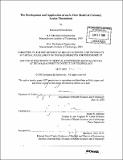| dc.contributor.advisor | Elazer R. Edelman. | en_US |
| dc.contributor.author | Kolandaivelu, Kumaran | en_US |
| dc.contributor.other | Harvard University--MIT Division of Health Sciences and Technology. | en_US |
| dc.date.accessioned | 2008-02-28T16:11:20Z | |
| dc.date.available | 2008-02-28T16:11:20Z | |
| dc.date.copyright | 2005 | en_US |
| dc.date.issued | 2005 | en_US |
| dc.identifier.uri | http://dspace.mit.edu/handle/1721.1/33069 | en_US |
| dc.identifier.uri | http://hdl.handle.net/1721.1/33069 | |
| dc.description | Thesis (Ph. D.)--Harvard-MIT Division of Health Sciences and Technology, 2005. | en_US |
| dc.description | Includes bibliographical references (v. 2, leaves 192-205). | en_US |
| dc.description.abstract | Thrombosis is an initiating response to vascular injury. Physiologically, this process aids in the repair and remodeling of the vessel wall. However, if left unchecked, luminal occlusion may rapidly occur. The coronary vascular bed is a life-sustaining environment in which pathological thrombosis can lead to devastating outcomes such as acute coronary syndromes or post-interventional thrombosis. In order to study these coronary thrombotic reactions, it is essential to consider the physical environment in which they occur. We have developed an in vitro method for creating pulsatile flows to mimic the coronary hernodynamic setting on a beat-to-beat basis. Furthermore, he have developed techniques and protocols to parametrically vary both the biological and physical aspects of thrombosis and in doing so, have investigated the effects of real-world temporal and spatial flow perturbations on local site platelet adhesion. Not only do such variations create quantitative differences in local reactions, but qualitative differences as well as various receptors must interact to create stable adhesions in a given hemodynamic environments. These findings have implications on the propensity for certain individuals to form clot under certain conditions, as well as the environment-dependent efficacy of various clinically relevant anti-thrombotic strategies. | en_US |
| dc.description.statementofresponsibility | by Kumaran Kolandaivelu. | en_US |
| dc.format.extent | 2 v. (205 leaves) | en_US |
| dc.language.iso | eng | en_US |
| dc.publisher | Massachusetts Institute of Technology | en_US |
| dc.rights | M.I.T. theses are protected by copyright. They may be viewed from this source for any purpose, but reproduction or distribution in any format is prohibited without written permission. See provided URL for inquiries about permission. | en_US |
| dc.rights.uri | http://dspace.mit.edu/handle/1721.1/33069 | en_US |
| dc.rights.uri | http://dspace.mit.edu/handle/1721.1/7582 | |
| dc.subject | Harvard University--MIT Division of Health Sciences and Technology. | en_US |
| dc.title | The development and application of an in vitro model of coronary lesion thrombosis | en_US |
| dc.type | Thesis | en_US |
| dc.description.degree | Ph.D. | en_US |
| dc.contributor.department | Harvard University--MIT Division of Health Sciences and Technology | |
| dc.identifier.oclc | 62147164 | en_US |
